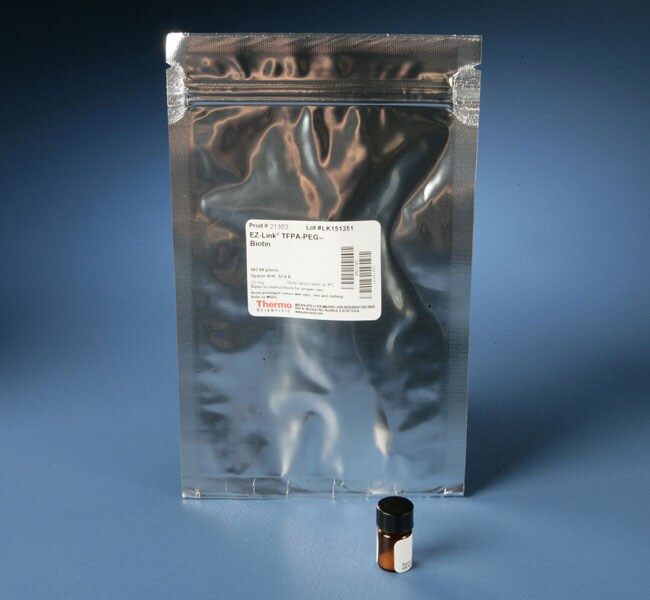
Thermo Scientific EZ-Link TFPA-PEG3-Biotin is an efficient, photoactivatable reagent based on tetrafluorophenyl azide for biotinylation and includes a 3-unit polyethylene glycol (PEG) spacer arm.
Features of EZ-Link TFPA-PEG3-Biotin:
• Biomolecular labeling—biotinylate proteins, DNA, RNA and many other macromolecules, even if they do not possess primary amines or sulfhydryl groups
• Photo-reactive—perfluorophenyl azido group activates upon exposure to ultraviolet light to form covalent bonds with nucleophiles and many other chemical groups
• Pegylated—spacer arm contains a hydrophilic, 3-unit, polyethylene glycol (PEG) group
• Enhances solubility—pegylation imparts water solubility to the biotinylated molecule, helping to prevent aggregation of biotinylated antibodies stored in solution
• Irreversible—forms permanent thioether bonds; spacer arm cannot be cleaved
• Solubility—best to dissolve in DMSO or DMF before further dilution in aqueous buffers
• Long reach —spacer arm (total length added to target) is 33.4 angstroms, minimizing steric hindrance for binding interactions with streptavidin
TFPA-PEG3-Biotin is a photoactivatable reagent for biotinylation of antibodies, proteins and many other kinds of macromolecules. The tetrafluorophenyl azide (TFPA) group activates upon exposure to UV-Light (maximum absorptivity is at 320 nm) to insert covalently at sites containing C-H or N-H bonds. The hydrophilic polyethylene glycol (PEG) spacer arm imparts water solubility that is transferred to the biotinylated molecule, thus reducing aggregation of labeled molecules stored in solution. The PEG spacer arm also gives this reagent a long and flexible connection to minimize steric hindrance involved with binding to avidin molecules.
We manufacture biotin reagents to ensure the highest possible overall product integrity, consistency, and performance for the intended research applications.
Biotinylation reagents differ in reactivity, length, solubility, cell permeability and cleavability. Several different types of photoreactive compounds are available. Aryl azide reagents activate upon exposure to ultraviolet light initiate addition reactions with double bonds, insertion into C–H and N–H sites, or subsequent ring expansion to react with a nucleophile (e.g., primary amines).
| Code | Description |
|---|---|
| 21303 | Catalog Number: 21303 |

